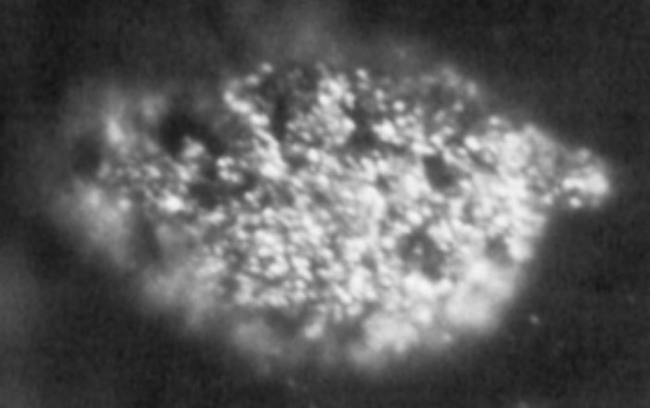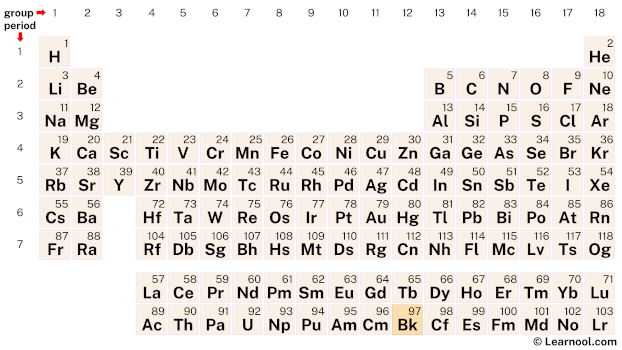
Berkelium (Bk) is a chemical element of the periodic table, located in the period 7, and has the atomic number 97. It is the ninth element in the actinide series. It is a soft, silvery-white metal which is named after the city of Berkeley, California, where it was first made. It is the fifth transuranium element and is counted as one of the radioactive elements.
On periodic table
| group | ⇨ | 1 | 2 | 3 | 4 | 5 | 6 | 7 | 8 | 9 | 10 | 11 | 12 | 13 | 14 | 15 | 16 | 17 | 18 |
| period | ⇩ | ||||||||||||||||||
| 1 | 1 H  Hydrogen |
2 He  Helium |
|||||||||||||||||
| 2 | 3 Li  Lithium |
4 Be  Beryllium |
5 B  Boron |
6 C  Carbon |
7 N  Nitrogen |
8 O  Oxygen |
9 F  Fluorine |
10 Ne  Neon |
|||||||||||
| 3 | 11 Na  Sodium |
12 Mg  Magnesium |
13 Al  Aluminium |
14 Si Silicon |
15 P  Phosphorus |
16 S  Sulfur |
17 Cl  Chlorine |
18 Ar  Argon |
|||||||||||
| 4 | 19 K  Potassium |
20 Ca  Calcium |
21 Sc  Scandium |
22 Ti  Titanium |
23 V  Vanadium |
24 Cr  Chromium |
25 Mn  Manganese |
26 Fe  Iron |
27 Co  Cobalt |
28 Ni  Nickel |
29 Cu  Copper |
30 Zn  Zinc |
31 Ga  Gallium |
32 Ge  Germanium |
33 As  Arsenic |
34 Se  Selenium |
35 Br  Bromine |
36 Kr  Krypton |
|
| 5 | 37 Rb  Rubidium |
38 Sr  Strontium |
39 Y  Yttrium |
40 Zr  Zirconium |
41 Nb  Niobium |
42 Mo  Molybdenum |
43 Tc  Technetium |
44 Ru  Ruthenium |
45 Rh  Rhodium |
46 Pd  Palladium |
47 Ag  Silver |
48 Cd  Cadmium |
49 In  Indium |
50 Sn  Tin |
51 Sb  Antimony |
52 Te  Tellurium |
53 I  Iodine |
54 Xe  Xenon |
|
| 6 | 55 Cs  Caesium |
56 Ba  Barium |
72 Hf  Hafnium |
73 Ta  Tantalum |
74 W  Tungsten |
75 Re  Rhenium |
76 Os  Osmium |
77 Ir  Iridium |
78 Pt  Platinum |
79 Au  Gold |
80 Hg  Mercury |
81 Tl  Thallium |
82 Pb  Lead |
83 Bi  Bismuth |
84 Po  Polonium |
85 At  Astatine |
86 Rn  Radon |
||
| 7 | 87 Fr  Francium |
88 Ra  Radium |
104 Rf  Rutherfordium |
105 Db  Dubnium |
106 Sg  Seaborgium |
107 Bh  Bohrium |
108 Hs  Hassium |
109 Mt  Meitnerium |
110 Ds  Darmstadtium |
111 Rg  Roentgenium |
112 Cn  Copernicium |
113 Nh  Nihonium |
114 Fl  Flerovium |
115 Mc  Moscovium |
116 Lv  Livermorium |
117 Ts  Tennessine |
118 Og  Oganesson |
||
| 57 La  Lanthanum |
58 Ce  Cerium |
59 Pr  Praseodymium |
60 Nd  Neodymium |
61 Pm  Promethium |
62 Sm  Samarium |
63 Eu  Europium |
64 Gd  Gadolinium |
65 Tb  Terbium |
66 Dy  Dysprosium |
67 Ho  Holmium |
68 Er  Erbium |
69 Tm  Thulium |
70 Yb  Ytterbium |
71 Lu  Lutetium |
|||||
| 89 Ac  Actinium |
90 Th  Thorium |
91 Pa  Protactinium |
92 U  Uranium |
93 Np  Neptunium |
94 Pu  Plutonium |
95 Am  Americium |
96 Cm  Curium |
97 Bk Berkelium |
98 Cf  Californium |
99 Es  Einsteinium |
100 Fm  Fermium |
101 Md  Mendelevium |
102 No  Nobelium |
103 Lr  Lawrencium |
|||||
| – f block |
Berkelium is found in the actinide series, a group of elements located at the bottom of the periodic table. Specifically, in period 7, between curium (Cm) and californium (Cf).
Element information
 |
|
 |
|
| Origin of name | named after Berkeley, a city in California |
| Symbol | Bk |
| Atomic number (Z) | 97 |
| Atomic mass | (247) |
| Block | f-block |
| Period | 7 |
| Classification | Actinide |
| Atomic radius | 170 pm |
| Melting point | 986 ℃, 1807 ℉, 1259 K |
| Boiling point | 2627 ℃, 4760 ℉, 2900 K |
| Electron configuration | [Rn] 5f9 7s2 |
| Learn how to write: Berkelium electron configuration | |
| Electrons per shell | 2, 8, 18, 32, 27, 8, 2 |
| Crystal structure | Double hexagonal close-packed (dhcp) |
| Phase at r.t | Solid |
| Density near r.t | 14.78 g/cm3 |
| Natural occurrence | Synthetic |
| Oxidation state | +3 |
| Electronegativity (Pauling scale) | 1.3 |
| Protons Neutrons Electrons |
97 150 97 |
| CAS number | 7440-40-6 |
| Discovered at | Lawrence Berkeley National Laboratory in 1949 |
History

Berkelium was first synthesized in December 1949 by a team of scientists led by Glenn T. Seaborg at the University of California, Berkeley. The team bombarded americium-241 with alpha particles in a cyclotron, which led to the formation of berkelium-243. The name “berkelium” was given to this element in honor of the city of Berkeley and the university located there.
The discovery of berkelium was significant not only because it added a new element to the periodic table, but also because it was the first time that a new element had been synthesized that was not a direct decay product of a previously known element. This breakthrough opened up new possibilities for the creation of heavier elements, and helped pave the way for the discovery of new elements in the transuranium series.
Berkelium has since been produced in larger quantities through the irradiation of heavier elements with neutrons in a nuclear reactor. It is typically recovered from nuclear reactor waste or from the debris of nuclear weapons tests. The production and isolation of berkelium is a complex process that involves several steps, including the chemical separation of the element from other fission products, the reduction of the berkelium ions to a lower oxidation state, and the purification of the resulting compound. Despite the challenges involved in producing and isolating this element, its unique properties make it an important research tool in fields such as nuclear physics, materials science, and biomedicine.
Occurrence
Berkelium is a synthetic element, meaning that it does not occur naturally in the Earth’s crust. It is produced by bombarding heavier elements with neutrons in a nuclear reactor. Berkelium-243 is the most common isotope of berkelium produced in this way, and it has a half-life of about 4.5 hours.
While berkelium is not found naturally on Earth, small traces of it have been detected in the debris from nuclear weapon tests conducted in the 1950s and 1960s. These tests released a significant amount of radioactive isotopes into the atmosphere, including berkelium-249, which has a half-life of about 330 days.
Because of its synthetic nature and the difficulty of producing it, berkelium is one of the rarest elements on Earth. It is typically only produced in very small quantities for scientific research purposes.
Production
Berkelium is produced by bombarding heavy atoms with high-energy particles in a process called nuclear transmutation. The production of berkelium starts with the isolation of americium-241 from spent nuclear fuel. Americium-241 is then bombarded with alpha particles in a nuclear reactor to create berkelium-247. Another method of producing berkelium is by bombarding curium-244 with alpha particles.
The process of producing berkelium is challenging and requires extreme care due to the high radioactivity of the materials involved. The production of berkelium is limited, and the element is only produced in small quantities each year.
Berkelium has been produced in several research reactors in the United States, including the High Flux Isotope Reactor (HFIR) at Oak Ridge National Laboratory and the Advanced Test Reactor (ATR) at Idaho National Laboratory.
Properties
Berkelium is a radioactive, silvery-white metal with a melting point of 986 ℃ and boiling point of 2627 ℃.
Its most stable isotope, berkelium-247, has a half-life of approximately 1,380 years.
Berkelium is a member of the actinide series and is found in the +3 and +4 oxidation states.
Berkelium exhibits both metallic and non-metallic characteristics.
It has a relatively low density of 14.78 g/cm3, but is highly reactive and can oxidize quickly in air or water.
Berkelium has a high radioactivity, emitting alpha particles and gamma rays.
Its isotopes can be used for a variety of applications, including in research on nuclear reactors and in the production of synthetic elements.
Berkelium is difficult to produce and only a few milligrams of the element have ever been produced.
Applications
Berkelium is primarily used in scientific research, particularly in nuclear physics and chemistry.
Its isotopes have been used in target preparation for the production of heavier elements and in the study of nuclear reactions.
It has also been used in the development of new nuclear fuels and in the investigation of the chemical properties of other transuranic elements.
Interesting facts
Berkelium was first synthesized in 1949 at the University of California, Berkeley, hence the name “berkelium.”
It is the first transuranium element to have observable quantities of isotopes that can be produced, isolated, and measured in macroscopic quantities.
Berkelium has the highest amount of isotopes among all synthetic elements.
Berkelium is not found naturally on Earth, but small amounts have been detected in the fallout debris of nuclear explosions.
The element is a silvery-white, radioactive metal that is difficult to handle due to its high radioactivity.
Berkelium has no known biological role and is highly toxic.
Berkelium has been used in nuclear research, particularly in the production of heavy isotopes of elements such as plutonium, curium, and americium.
It has also been used in the development of new radiation detection instruments and as a target material for the production of new elements.
Berkelium has been the subject of several fictional depictions, including being a plot element in the book and movie “The Peacemaker,” where it is stolen to construct a nuclear bomb.
Related
More elements
External links
- https://en.wikipedia.org/wiki/Berkelium
- https://www.rsc.org/periodic-table/element/97/berkelium
- https://www.britannica.com/science/berkelium
- https://pubchem.ncbi.nlm.nih.gov/element/Berkelium
- https://www.chemicool.com/elements/berkelium.html
- https://www.livescience.com/40238-berkelium.html
- https://www.thoughtco.com/berkelium-element-facts-bk-3863126
Deep
Learnool.com was founded by Deep Rana, who is a mechanical engineer by profession and a blogger by passion. He has a good conceptual knowledge on different educational topics and he provides the same on this website. He loves to learn something new everyday and believes that the best utilization of free time is developing a new skill.
